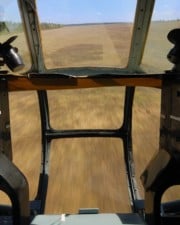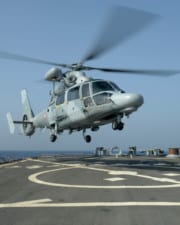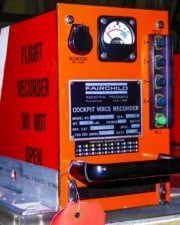Helicopters often appear to fly at relatively low altitudes compared to other aircraft. This may lead people to wonder how high a helicopter can truly fly. Are they able to achieve the same altitude as airplanes? What happens if they go too high?
TLDR – Helicopters with turbine engines can reach altitudes of 25,000 feet during forward flight. However, helicopters cannot fly as high when hovering. The typical maximum height for a hovering helicopter is about 12,000.
How High Do Helicopters Usually Fly?
Helicopters typically fly at altitudes of 10,000 feet, which provides the optimal atmosphere for maneuvering. As the helicopter climbs in altitude, the air gets thinner, requiring the blades to work harder to generate the same amount of lift.
Most helicopter pilots consider 10,000 feet the upper limit of the ideal altitude for flying. With increased altitude, the blades receive more drag and create less forward airspeed and climb performance. The stability and maneuverability of the helicopter start to decrease.
Helicopters can achieve flight by generating lift. The wings create upward force by deflecting air downward. Rotary motion provides one of the easiest ways to generate lift by allowing the wings to continuously move.
On a helicopter, the wings (blades) are fixed to a rotating wing assembly called the main rotor. A tail rotor is used to keep the body of the helicopter from spinning. By slightly angling the main rotor and rotating the blades, the helicopter can travel forward, backward, and sideways. When traveling forward, the blades generate more lift compared to hovering, allowing the helicopter to climb higher.
Air density is an important component for generating lift and allowing engines to breathe efficiently. With thinner air, the main rotor generates less lift, limiting the ability of the helicopter to ascend any higher.
Higher altitudes also pose a risk to pilots and passengers. The thinner atmosphere includes less oxygen, which is why the Federal Aviation Administration (FAA) requires an oxygen mask at altitudes of 12,500 feet or higher.
How Low Can Helicopters Fly?
A helicopter can technically fly just a few feet above the ground. There is no legal minimum altitude for flying a helicopter. However, pilots must ensure that their flight does not create a hazard to persons or properties on the ground.
Other types of aircraft must maintain an altitude of 1,000 feet above the highest obstacle when flying over congested areas. Helicopters do not need to follow the same requirements due to the potential need for an emergency landing and increased use by medical and law enforcement agencies.
Outside of the United States, the regulations may vary. However, it is common for aviation authorities to allow helicopters to fly at lower altitudes compared to other low-flying aircraft.
How High Do Police Helicopters Fly?
While helicopters often fly at altitudes of 10,000 feet over rural areas, police helicopters often need to maintain lower altitudes to patrol the city streets and track or search for suspects. The FAA does not set a minimum operating altitude for helicopters. However, the agency recommends flying no lower than 1,000 feet over cities.
Many police departments and law enforcement agencies follow the FAA recommendations. They may occasionally fly lower to get a better view of the ground or provide backup for ground units. It is not uncommon for police helicopters to fly as low as 500 feet above sea level.
Police helicopters are often equipped with thermal imaging equipment and spotlights. By flying lower, they can help officers on the ground search for suspects or maintain a perimeter around a crime scene.
Helicopters used for flying patients to hospitals also typically fly at 1,000 feet over cities. However, the helipads that police and medical helicopters land on are often located on top of buildings with heights of 100 feet or less.
What Happens If a Helicopter Flies Too High?
As the helicopter ascends, the air begins to thin. With thinner air, the main rotor becomes less efficient. The higher the helicopter flies, the slower it ascends due to the reduced power generated by the rotor.
Eventually, the helicopter may reach a point where the air is too thin. When the blades can no longer generate enough lift to keep ascending, the helicopter reaches its maximum operating envelope (the coffin corner).
As a pilot approaches the maximum operating envelope, they typically experience extreme turbulence. The helicopter begins to vibrate or rattle.
When the helicopter surpasses its maximum operating envelope, the helicopter becomes incredibly unstable. It is likely to pitch upward and roll to the left. The blades may also stall, causing the helicopter to become powerless.
Can a Helicopter Fly Above the Clouds?
A helicopter can fly above the clouds. Low clouds, including stratus clouds, cumulus clouds, and stratocumulus clouds appear at about 6,000 feet. Helicopters often operate at 10,000 feet, allowing them to pass over the low clouds and through the middle clouds, which appear at altitudes of 6,500 feet to 13,000 feet.
What Is the Record for Highest Altitude in a Helicopter?
The record for the highest altitude flight in a helicopter is 40,820 feet. It was set in 1972 by French aviator Jean Boulet while piloting an SA 315 Lama, which is a single-engine helicopter. The record stands to this day.
Along with achieving the highest altitude recorded in a helicopter, the flight set a couple of additional records. When Boulet began descending, the cold environment caused the engine to flame out. He landed with no power, setting the record for the highest ever, full-touchdown autorotation, and the largest altitude flown with an auto-gyro.
Can a Helicopter Fly to the Top of Mount Everest?
After reading about the record for the highest altitude, a helicopter test pilot named Didier Delsalle came up with the idea of landing a helicopter on Mount Everest, which is the highest mountain peak in the world.
In May 2005, Delsalle completed his goal and became the first helicopter pilot to land a plane on the top of Mount Everest. The peak of the mountain is 29,000 feet high, which surpasses the maximum operating altitude of 23,000 feet for the aircraft that Delsalle flew. The flight involved years of planning and several test flights.
Related Posts














